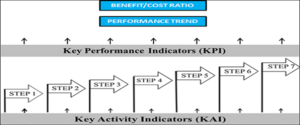
The Relationship Life Cycle is the next phase beyond the customer life cycle. The customer life cycle assumed that a seller should simply aggregate the value of all the orders that can be expected to be received (repeat business, additional sales etc.) and therefore not risk future revenue by short-term efforts. This equation was very simple and the further the so-called relationship went, the less remaining revenue was forecast as the assumption was that some portion of the forecast had been realized.
For example, let’s say that a new vacuum cleaner costs $200. Let’s say that the technology of the cleaner typically implies a product life cycle of five good years with little or no maintenance and then rapidly decreasing utility. After ten years it is assumed that the unit is useless. Using the Product Life Cycle approach the seller optimizes the deal around the individual transaction. Thus ensuring the highest price. This is in stark contrast with the desires of the buyer who generally will tend to drive the price down.
The customer life cycle steps in and says that if a reasonably good job of customer service is demonstrated through the life cycle of the product (e.g. free or discounted maintenance and so on) then the buyer might come back to the same seller to get a replacement. Therefore the buyer is not looked at as a single price tag of $200, but as a possible series of price tags for $1,000 over the duration of the buyer/seller lifetime. In other words, if the brand and service can suitably impress a particular shopper, he or she will continue to buy the same product or a suitable replacement until the buyer no longer needs such equipment, all other things being equal. The result is that the initial order price is no longer maximized to the detriment of the long-term repeat business that might be accrued. Additional costs and investments may be needed on the behalf of the seller in order to attract such repeat business.
However, the relationship life cycle steps in here also. With the bi-directional flow of information that comes about as a response to true collaboration, the buyer and seller can work together to better maximize their joint benefits. In other words, what if the buyer and seller worked jointly to better understand the customers’ customer needs so that they can both serve them better than any other competing value chain? In the B2B sense, this would mean that a buyer and seller collaborate as strategic partners and exploit each other’s assets to further serve and surpass the customers’ customer service expectations. This would lead not only to repeat business but new business, new segments, new locations or geographies, new industries and so on. This is not achieved through the simple view of aggregation of a series of hoped-for orders. This is achieved through a deep commitment or marriage between companies who share a common strategy. It is a rare thing but when achieved, it can create dynamics in a value chain that other companies will pale under the threat. This is the value of a Relationship Life Cycle. Some may argue that this description fits their interpretation of Customer life Cycle. If this is the case, I would suggest that they are stretching the original goal of the model and are in fact simply supporting the objectives and philosophies of the Relationship Life Cycle.
Collaborative Planning, Forecasting and Replenishment (CPFR) is a perfect example of a process model that takes as its basis the objectives described by a Relationship Life Cycle. CPFR looks beyond a single transaction, and even beyond all the orders that are needed to be satisfied over the current planning horizon. It engenders a relationship such that buyer and seller intend to change the rules of competition in that value chain. Vendor Managed Inventory (VMI) and other Continuous Replenishment Strategies are good examples of “best practices” associated with the Customer Life Cycle view. All are excellent models that meet the objectives set by companies at those times.Collaborative Planning, Forecasting and Replenishment and CPFR are Registered Trade Marks of the Voluntary Inter-Industry Commerce Standards association.




